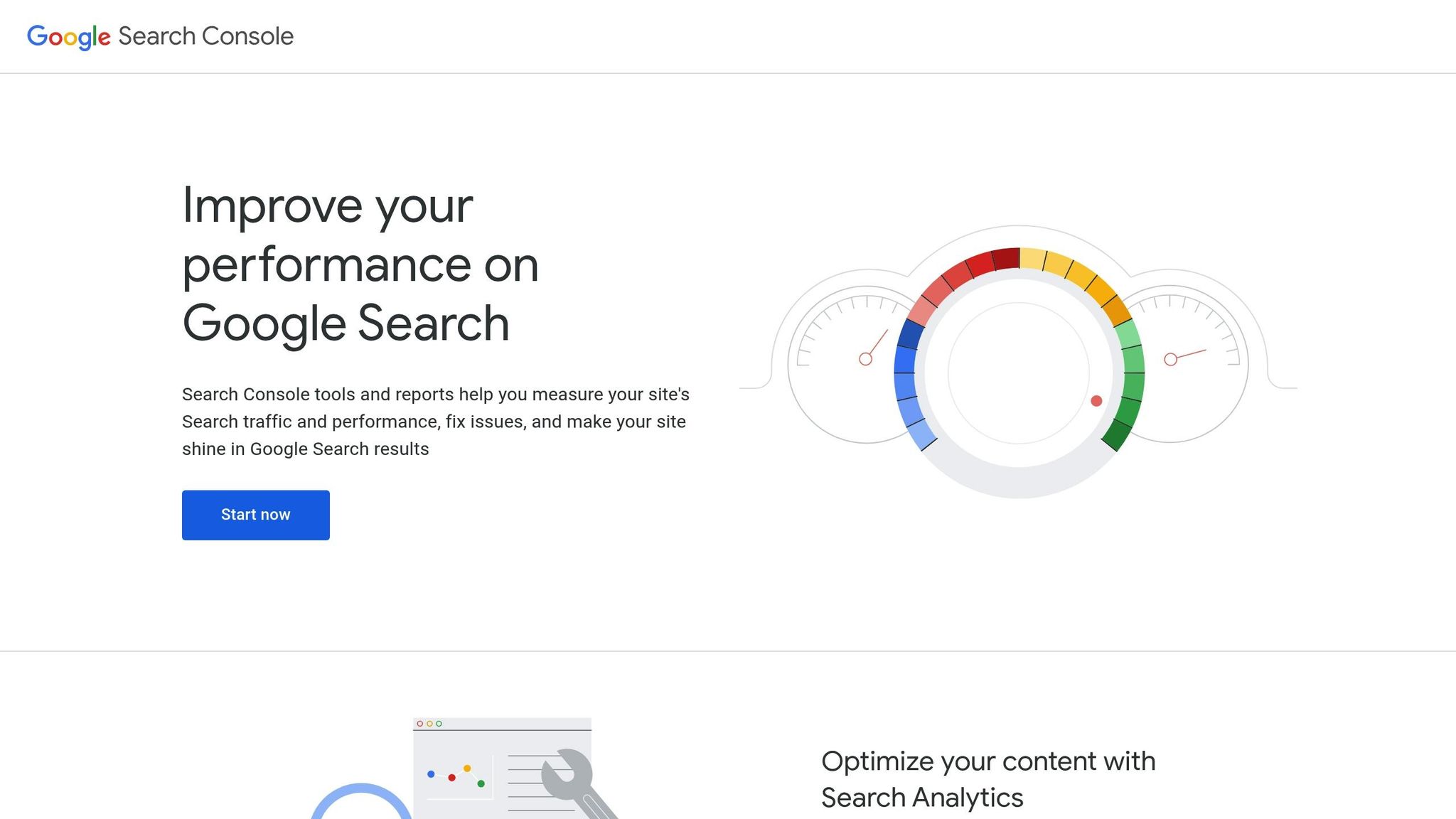When Google says "Discovered – currently not indexed", it means your page exists, but it hasn’t been added to search results yet. This can hurt your site’s visibility and SEO. Common reasons include low-quality content, technical issues, or crawl budget limits.
Quick Fix Summary:
- Check Problem URLs: Use Google Search Console to find affected pages.
- Improve Content: Fix thin or low-quality content and update meta tags.
- Fix Technical Issues: Resolve crawl errors, speed up page loading, and optimize sitemaps.
- Enhance Site Structure: Add internal links, clean up redirects, and optimize for mobile.
Key Tip: Prioritize fixing important pages first, like product or service pages, to recover traffic quickly.
Finding Problem URLs
Google Search Console URL Check

Start with the Coverage report in Google Search Console. Go to the "Pages" section and filter for the "Discovered – currently not indexed" status. This will show all URLs that Google has identified but hasn’t included in its search index.
Export the list of affected URLs and take note of these details:
- Total number of URLs
- Discovery date for each URL
- Patterns in URL structures
- Changes in status over time
Reading Crawl Data
Dive into crawl data to figure out why certain pages aren’t being indexed. Use server logs and the crawl stats section in Google Search Console to review:
- How often crawlers visit the site
- Which sections of the site get more crawler attention
- Server response times
- Crawl errors or blocks from robots.txt
- Page load speeds
- Pages that crawlers barely visit
This analysis can help identify technical issues that might be preventing proper indexing.
Which URLs to Fix First
Focus on fixing URLs based on their business importance and SEO potential. Here’s a quick guide:
| Priority Level | URL Characteristics | Action Timeline |
|---|---|---|
| Critical | Revenue-driving pages, main product categories | Fix within 24–48 hours |
| High | Blog posts targeting competitive keywords, key service pages | Fix within 1 week |
| Medium | Supporting content, older blog posts | Fix within 2–3 weeks |
| Low | Archive pages, tag pages | Fix as time allows |
When deciding priorities, consider factors like organic traffic potential, commercial importance, fresh content, strong internal links, and conversion opportunities. Use crawl data insights to decide which URLs need immediate attention.
[Solved] Discovered / Crawled – Currently Not Indexed Issue in …
Content Quality Fixes
Improving content quality helps address indexing issues by aligning with both search engine requirements and user expectations.
Fixing Low-Quality Content
Start with a thorough content audit. Identify pages that don’t fully meet user needs or match search intent. Expand thin content to provide detailed, useful information. After improving the depth of your content, update meta tags to clearly highlight the page’s main focus.
Better Meta Tags and Headers
Refine your meta tags and headers to clearly communicate the purpose and value of your page. Make sure these elements are concise and relevant. Once updated, weave in keywords naturally to boost clarity and alignment with search intent.
Keyword Implementation
Use targeted keywords in a way that feels natural. This not only improves relevance but also aligns with the intent of your audience.
sbb-itb-880d5b6
Technical Solutions
Once content quality is sorted, it’s time to address technical issues that can hinder your site’s performance in search results. These technical tweaks work hand-in-hand with your content improvements to keep your SEO in top shape.
Fix Crawl Errors
Use Google Search Console to identify and resolve crawl errors. Focus on these key areas:
- Server response codes: Repair pages showing 4XX or 5XX errors.
- Robots.txt directives: Remove any rules that unintentionally block search engines.
- Noindex tags: Correct any accidental use of noindex meta tags.
- URL structure: Simplify and clean up parameters to avoid duplicate content.
Fixing these issues ensures search engine crawlers can navigate your site without roadblocks, which can directly affect your rankings.
Speed Up Page Loading
Improving page load times helps both users and search engines. Concentrate on these elements:
- Server response time: Reduce delays in the initial connection.
- Image optimization: Compress images and apply lazy loading techniques.
- Resource minification: Shrink CSS, JavaScript, and HTML files.
- Browser caching: Enable caching for static resources to speed up repeat visits.
Faster pages not only enhance the user experience but also improve your site’s crawlability.
Sitemap Management
An effective XML sitemap helps search engines understand your site’s structure. Follow these best practices:
- Regular updates: Keep it current with new or updated content.
- Manage size: Split large sitemaps into smaller, more manageable files.
- Set priorities: Highlight key pages with higher priority values.
- Change frequency: Specify how often content is updated.
After making changes, resubmit your sitemap in Google Search Console and monitor its performance. Be sure to exclude non-canonical URLs and irrelevant pages to maintain a clean and efficient sitemap.
Site Structure Improvements
A well-organized website makes it easier for search engines to find and index your pages.
Better Internal Links
Here’s how you can improve your internal linking:
- Link key pages directly from your homepage and main navigation.
- Use anchor text that clearly describes the linked content and includes relevant keywords.
- Group related content into clusters by linking them together.
- Make sure important pages are no more than three clicks away from the homepage.
- Add natural, contextual links within your content to guide users and search engines.
Keep your high-priority pages close to the homepage and maintain a consistent internal linking strategy to boost discoverability.
Clean Up Redirects
Redirect chains can slow down search engine crawlers and waste resources. Simplify your redirect structure by following these steps:
- Remove unnecessary redirect chains that create extra URL hops.
- Replace temporary (302) redirects with permanent (301) redirects where needed.
- Fix broken internal links that point to redirected URLs.
- Update external links to lead directly to the final destination URLs.
- Regularly monitor redirects using tools like Google Search Console.
A streamlined redirect setup ensures search engines can navigate your site efficiently without getting bogged down by loops or redundant jumps.
Mobile Page Setup
With mobile-first indexing, optimizing your site for mobile devices is critical. Focus on these elements:
- Use responsive design to make your site work seamlessly on all screen sizes.
- Ensure the content on your mobile site matches the desktop version.
- Optimize images, make navigation simple, and design for touch-friendly interactions.
- Test your mobile usability using Google’s Mobile-Friendly Test tool.
Mobile optimization isn’t just about improving user experience – it directly affects how search engines crawl and index your site. A well-prepared mobile setup ensures your pages are indexed accurately and without delays.
With these structural improvements in place, you’re ready to tackle the final steps for optimizing your site’s indexing.
Next Steps
Quick Fix Checklist
Use this checklist to keep track of your indexing fixes:
- Audit Current Status: Check Google Search Console every week to spot newly discovered but non-indexed pages.
- Content Assessment: Improve thin content pages that have fewer than 300 words.
- Technical Review: Make sure your robots.txt file and meta robots tags aren’t accidentally blocking indexing.
- Speed Check: Confirm that your pages load in under 3 seconds on mobile devices.
- XML Sitemap: Resubmit your sitemap after making major updates.
If these steps don’t solve the problem, it might be time to seek professional help.
Professional Help Options
For persistent indexing problems, professional services can offer tailored solutions. SearchX specializes in tackling these challenges with detailed technical SEO audits and hands-on implementation.
"We craft tailored SEO plans based on your business’s unique needs. From day one, we focus on what matters most to you – whether it’s increasing leads, boosting conversions, or improving rankings." – SearchX
Here’s what they offer:
- Custom strategies to address your website’s specific indexing problems
- Real-time tracking of your indexing status
- Technical optimizations to meet search engine standards
- Regular updates and progress tracking
Regular Index Checks
Stay on top of indexing by monitoring consistently:
1. Daily Monitoring
Use Google Search Console daily to catch new indexing issues and address them within 24 hours.
2. Weekly Audits
Conduct detailed audits of your indexed pages, focusing on:
- Trends in the coverage report
- Newly discovered URLs
- Changes in indexing rates
- Differences between mobile and desktop indexing
3. Monthly Reviews
Evaluate overall indexing health by reviewing:
- Total indexed pages compared to submitted URLs
- Crawl budget usage
- Improvements in index coverage
- Key technical SEO metrics







